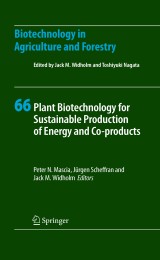Details

Plant Biotechnology for Sustainable Production of Energy and Co-products
Biotechnology in Agriculture and Forestry, Band 66
|
149,79 € |
|
| Verlag: | Springer |
| Format: | |
| Veröffentl.: | 15.09.2010 |
| ISBN/EAN: | 9783642134401 |
| Sprache: | englisch |
| Anzahl Seiten: | 458 |
Dieses eBook enthält ein Wasserzeichen.
Beschreibungen
This book is a collection of chapters concerning the use of biomass for the sustainable production of energy and chemicals–an important goal that will help decrease the production of greenhouse gases to help mitigate global warming, provide energy security in the face of dwindling petroleum reserves, improve balance of payment problems and spur local economic development. Clearly there are ways to save energy that need to be encouraged more. These include more use of energy sources such as, among others, manure in anaerobic digesters, waste wood in forests as fuel or feedstock for cellulosic ethanol, and conservation reserve program (CRP) land crops that are presently unused in the US. The use of biofuels is not new; Rudolf Diesel used peanut oil as fuel in the ?rst engines he developed (Chap. 8), and ethanol was used in the early 1900s in the US as automobile fuel [Songstad et al. (2009) Historical perspective of biofuels: learning from the past to rediscover the future. In Vitro Cell Dev Biol Plant 45:189–192). Brazil now produces enough sugar cane ethanol to make up about 50% of its transportation fuel needs (Chap. 4). The next big thing will be cellulosic ethanol. At present, there is also the use of Miscanthus x giganteous as fuel for power plants in the UK (Chap. 2), bagasse (sugar cane waste) to power sugar cane mills (Chap. 4), and waste wood and sawdust to power sawmills (Chap. 7).
to Biofuels.- Overview: World Energy Resources and the Need for Biomass for Energy and Lower Fossil Carbon Dioxide Emissions.- Designing Biomass Crops with Improved Calorific Content and Attributes for Burning: a UK Perspective.- Designing Plants To Meet Feedstock Needs.- Specific Biofuel Feedstocks.- Engineering Advantages, Challenges and Status of Sugarcane and other Sugar-Based Biomass Resources.- High Fermentable Corn Hybrids for the Dry-Grind Corn Ethanol Industry.- Engineering Advantages, Challenges and Status of Grass Energy Crops.- Woody Biomass and Purpose-Grown Trees as Feedstocks for Renewable Energy.- Engineering Status, Challenges and Advantages of Oil Crops.- Mitigating Invasiveness.- Invasive Species Biology, Ecology, Management and Risk Assessment: Evaluating and Mitigating the Invasion Risk of Biofuel Crops.- Gene Flow in Genetically Engineered Perennial Grasses: Lessons for Modification of Dedicated Bioenergy Crops.- Genetic Modification in Dedicated Bioenergy Crops and Strategies for Gene Confinement.- Models for Uses of Biomass Feedstocks.- Integrated Biorefineries—A Bottom-Up Approach to Biomass Fractionation.- Heat and Power Production from Stover for Corn Ethanol Plants.- Agricultural Fit of Biomass Crops and Lifecycle Analysis and Criteria.- The Problem is the Solution: the Role of Biofuels in the Transition to a Regenerative Agriculture.- Life-Cycle Analysis of Biofuels.- Criteria for a Sustainable Bioenergy Infrastructure and Lifecycle.
The successful use of plant biomass for the sustainable production of energy and co-products such as chemicals is critically important for the future of humanity. Large scale exploitation of biomass is needed to decrease the production of greenhouse gases and help mitigate global warming, to provide energy security in the face of declining petroleum reserves, to improve balance of payment imbalances, and to spur local economic development.
This volume discusses such uses of plant biomass as well as ways to improve the productivity and composition of plant species, including trees, perennial and annual grasses, oil-producing plants and algae, that have the potential to produce substrates such as sugar, starch, oil and cell walls, as well as energy and co-product substrates. The problems of invasiveness and gene dispersal are discussed, as are ways to mitigate these. Among the topics covered are models for integrated biorefineries to produce many co-product chemicals, the use of corn stover to power ethanol plants, life cycle analysis of biofuels, and criteria for biomass sustainability and certification. This is indeed an exciting and fast-moving time for advocates of plant biomass-based technology.
This volume discusses such uses of plant biomass as well as ways to improve the productivity and composition of plant species, including trees, perennial and annual grasses, oil-producing plants and algae, that have the potential to produce substrates such as sugar, starch, oil and cell walls, as well as energy and co-product substrates. The problems of invasiveness and gene dispersal are discussed, as are ways to mitigate these. Among the topics covered are models for integrated biorefineries to produce many co-product chemicals, the use of corn stover to power ethanol plants, life cycle analysis of biofuels, and criteria for biomass sustainability and certification. This is indeed an exciting and fast-moving time for advocates of plant biomass-based technology.
Discusses the possible uses of plant biomass Covers cutting-edge research and development Written by top scientists Includes supplementary material: sn.pub/extras
Diese Produkte könnten Sie auch interessieren:

Decision Support Systems for Risk-Based Management of Contaminated Sites

von: Antonio Marcomini, Glenn Walter Suter II, Andrea Critto

96,29 €

Dynamics of Mercury Pollution on Regional and Global Scales

von: Nicola Pirrone, Kathryn R. Mahaffey

149,79 €














